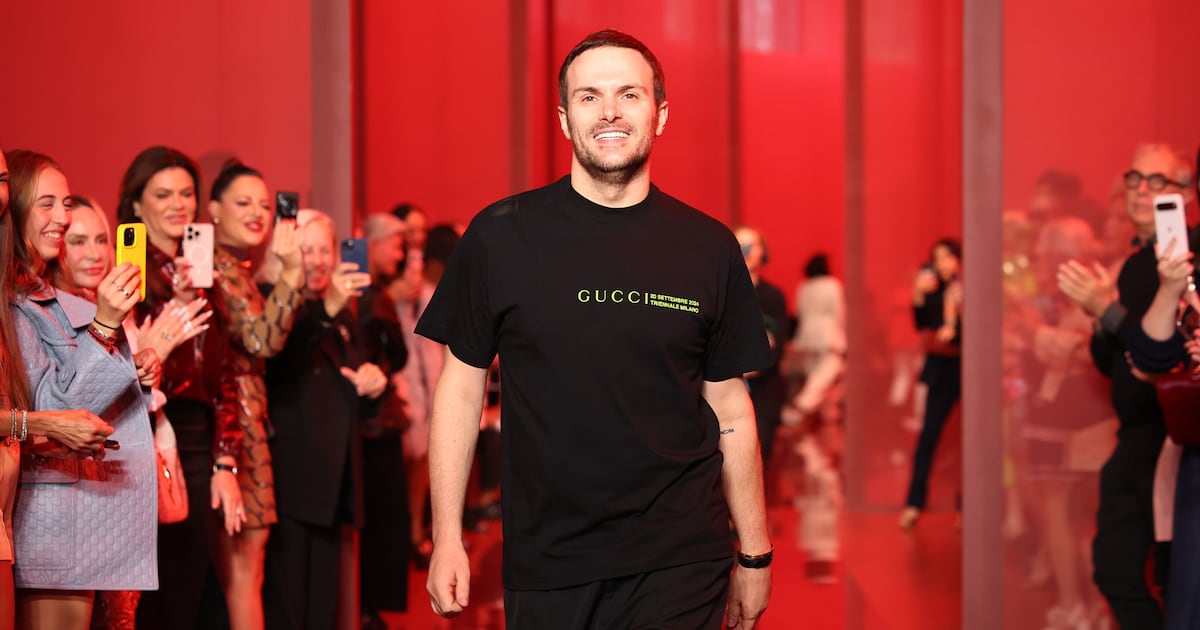
Two years after Sabato de Sarno was appointed to take the creative reins at a flagging Gucci, his efforts to revive consumer demand for the Italian megabrand have run out of road.
The company announced his departure Thursday, just days before owner Kering is set to report its annual results. Gucci, Keringâs biggest and most profitable brand, has been in a sustained slump, with revenue down 26 percent year-on-year in the third quarter.
De Sarnoâs exit is effective immediately: his designs wonât feature on the runway during Milan Fashion Week later this month. Instead the collection on display during Gucciâs Feb. 25 womenswear show will be designed by the design studio, the brand said in a statement.
Whatâs behind De Sarnoâs departure?
Though sudden, De Sarnoâs departure was no surprise.
The Neapolitan designer was appointed to restore a more stable, classic feel to Gucciâs aesthetic; an antidote to the radical, maximalist aesthetic of his predecessor, Alessandro Michele, which (in tandem with a commercial strategy that leaned heavily into more accessibly-priced streetwear and accessories) drove huge sales â until it didnât.
But amid a broader post-pandemic slowdown in luxury demand, De Sarnoâs more restrained approach failed to generate anywhere near the buzz created by Michele (or Tom Ford, who presided over the brandâs previous boom), and Gucciâs sales fell further behind peers.
âThe writing was on the wall,â said Bernstein analyst Luca Solca. âThe demure style of Sabato De Sarno didnât fit the exuberant image that consumers have built of Gucci in the past 30 years.â
The issues werenât with design alone. Logistical shortcomings and supply-chain lags meant De Sarnoâs designs trickled into stores, giving customers that might have wanted to purchase them limited access. Kering deputy CEO Francesca Belletini told BoF in September that the first real wave of deliveries that would test customer appetite for the new collections was only just hitting stores. And yet De Sarnoâs vision, when it did finally hit, failed to ignite sales.
The designerâs exit comes amid a broader shakeup in Gucciâs top ranks. Luxury veteran Stefano Cantino was named CEO in October, and lost little time in shaking up the brandâs marketing and communications team. More of that kind of swift, decisive action may be what Gucci needs.
Who could take over Gucciâs creative helm?
The pace of luxuryâs designer musical chairs is particularly frenetic at present, leaving the brand spoiled for choice.
Hedi Slimane left LVMH-owned Celine in October and would be a top choice for Gucci. The star designer is regarded as an exceptional talent, with an edgy but classic point of view that packs commercial punch. During his tenure, annual sales at Celine more than doubled to â¬2.5 billion ($2.6 billion), according to analyst estimates (LVMH does not break out performance by brand). He previously helped Kering transform Saint Laurent into a billion-dollar business, though his 2016 split with the company turned into a messy divorce, and how well his French aesthetic would work for Italian Gucci is an open question.
Kim Jones, who left Dior Homme last week, would be another interesting pick. Jones has always wanted to design menâs and womenâs under one label and Gucci would give him that opportunity. He designed Fendiâs womenswear for four years, but his work there underscored his relative lack of experience as a womenâs designer, a crucial segment for Gucci.
Diorâs womenâs designer Maria Grazia Chiuri might also make sense should she exit the brand this spring and return to Italy as some sources predict. During her tenure at Dior, sales quadrupled, but whether she could boost Gucciâs fashion quotient is uncertain.
Jonathan Anderson could be a fresh choice if Gucci is looking for a designer who defines the zeitgeist and has proven his ability to breathe new life into a brand. Anderson turned Loewe into a multi-billion-dollar business, where he has gained extensive leather goods experience. But the designer may be headed to Dior, according to sources, and the fact that his JW Anderson label is tied to LVMH makes it unlikely he would leave the group.
This time around, Gucci is far less likely to take a chance on a relatively untested creative director. The once-unknown Michele fuelled explosive growth for the brand. But De Sarno, a behind-the-scenes designer at Valentino before he joined Gucci, has not â and itâs highly improbable that management would take a risk like that again.
Whatâs at stake for Gucci?
Without exaggerating: everything. And not just for Gucci. The brand accounts for roughly half of Keringâs revenue and two-thirds of operating profit, dictating the fortunes of one of luxuryâs largest players.
âGucci is more than ever central to Keringâs equity story,â said Citi analyst Thomas Chauvet. The brandâs underperformance has dragged on the groupâs share price and valuation for the last five years, he noted.
Shareholders reacted positively to the news of De Sarnoâs exit. Keringâs shares rose 3 percent in Thursday trading. But the luxury group will need to show rapid progress both creatively and operationally to start to restore investor confidence in its long-awaited Gucci turnaround.
âI donât expect Keringâs results to give much of a reason to celebrate next week, as the Gucci revival remains work in progress,â said Solca. âHopefully Kering will announce a big name to replace De Sarno. But with the fashion show pending, I wonder.â

